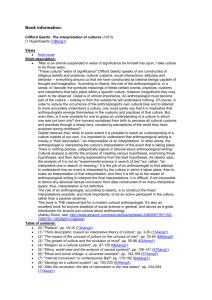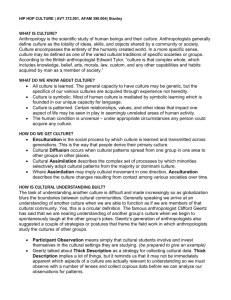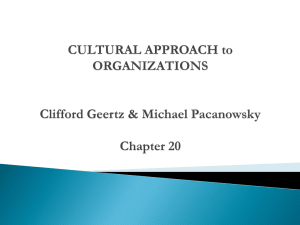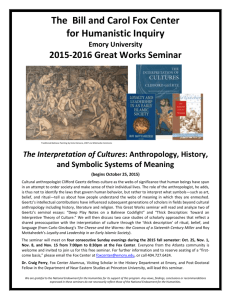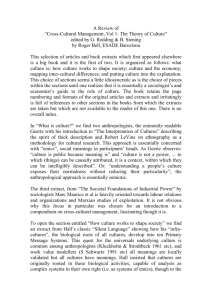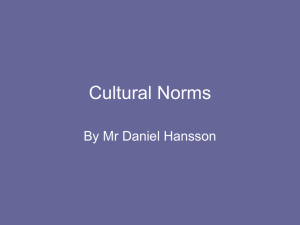Culture and Communication
advertisement
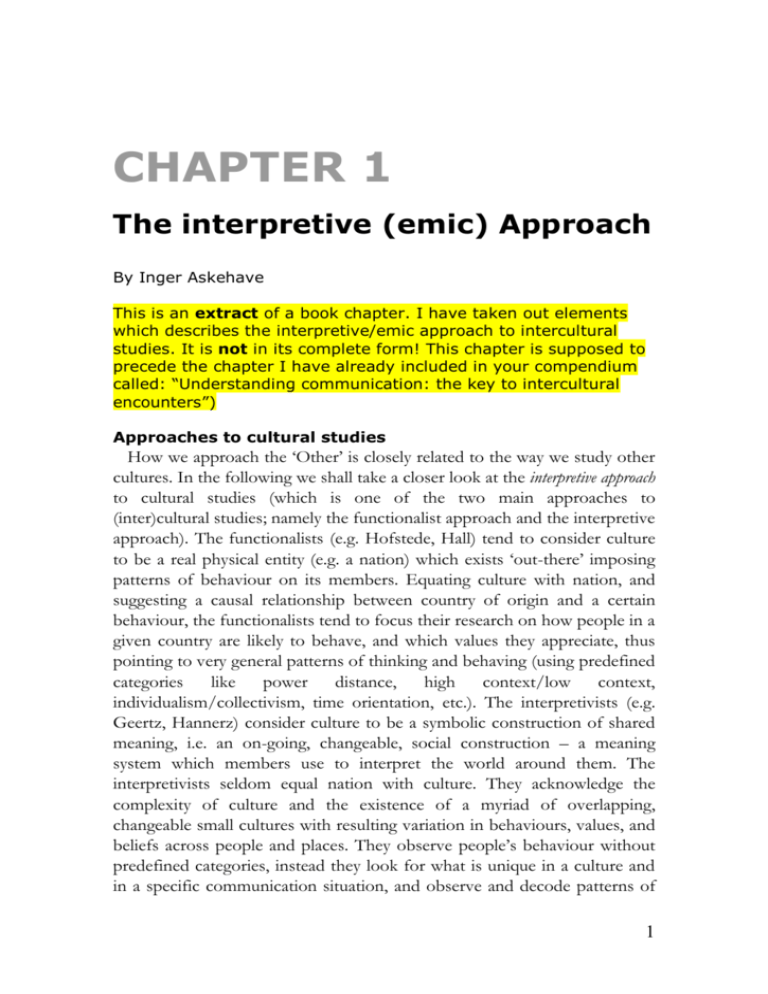
CHAPTER 1 The interpretive (emic) Approach By Inger Askehave This is an extract of a book chapter. I have taken out elements which describes the interpretive/emic approach to intercultural studies. It is not in its complete form! This chapter is supposed to precede the chapter I have already included in your compendium called: “Understanding communication: the key to intercultural encounters”) Approaches to cultural studies How we approach the ‘Other’ is closely related to the way we study other cultures. In the following we shall take a closer look at the interpretive approach to cultural studies (which is one of the two main approaches to (inter)cultural studies; namely the functionalist approach and the interpretive approach). The functionalists (e.g. Hofstede, Hall) tend to consider culture to be a real physical entity (e.g. a nation) which exists ‘out-there’ imposing patterns of behaviour on its members. Equating culture with nation, and suggesting a causal relationship between country of origin and a certain behaviour, the functionalists tend to focus their research on how people in a given country are likely to behave, and which values they appreciate, thus pointing to very general patterns of thinking and behaving (using predefined categories like power distance, high context/low context, individualism/collectivism, time orientation, etc.). The interpretivists (e.g. Geertz, Hannerz) consider culture to be a symbolic construction of shared meaning, i.e. an on-going, changeable, social construction – a meaning system which members use to interpret the world around them. The interpretivists seldom equal nation with culture. They acknowledge the complexity of culture and the existence of a myriad of overlapping, changeable small cultures with resulting variation in behaviours, values, and beliefs across people and places. They observe people’s behaviour without predefined categories, instead they look for what is unique in a culture and in a specific communication situation, and observe and decode patterns of 1 thinking (meaning systems) which are specific to a particular small culture or cultural group and which are meaningful and relevant to the members of the culture in question. In other words they try to interpret what they see from the insiders’ perspectives, thereby cracking the code of meaning of a particular cultural group. The Interpretive Approach As the name suggests, the interpretive approach is concerned with interpretation and understanding which relate both to the way the interpretivists define ‘culture’ and the methods they use to conduct intercultural research. In spite of its widespread use within anthropology, the interpretive approach is a new-comer within business contexts, but offers interesting insights, which are extremely valuable for the international business community as well. Clifford Geertz, Professor of Social Science at the Institute for Advanced Study at Princeton University, is one of the leading figures within the interpretive approach. Geertz defines culture as a system of symbols, or as “webs of significance“: "The concept of culture I espouse […] is essentially a semiotic one. Believing, with Max Weber, that man is an animal suspended in webs of significance he himself spun, I take culture to be those webs, and the analysis of it to be therefore not an experimental science in search of law but an interpretive one in search of meaning." (Geertz 1973: 4-5) He elaborates on his concept of culture, by pointing to the way people use webs of significance: “[Culture is] a system of inherited conceptions expressed in symbolic forms by means of which people communicate, perpetuate, and develop their knowledge about and attitudes toward life." (Geertz 1973: 89) Suggesting that culture is ‘webs of significance’ essentially means that culture helps us learn and manage what is meaningful or makes sense to us and others in a given culture or more specifically in a given context. Culture becomes a meaning universe we use to conduct and interpret events and actions around us in a meaningful way. However, in the interpretive approach, it is claimed that there is no one-to-one relation between thoughts, words and behaviour as suggested by the functionalists. People are to some extent guided by their values, but their actual behaviour is 2 constantly modified and conditioned by the context, their interests and experiences (see also chapter 2) In other words, culture is much more than a question of nationality; the social context plays a significant role in terms of how we add meaning to things, and so does the individual and his or her interests and experiences. Thus Geertz sees people as entangled in meanings which frame their lives and opportunities. These meanings are passed on from one generation to the next – but not in an unchangeable and static form. Cultures are considered dynamic and changeable as people continually construct and reconstruct their ‘webs of significance’: “When you see a river from afar, it may look like a blue (or green, or brown) line across a landscape; something of awesome permanence. But at the same time “you cannot step into the same river twice,” for it is always moving, and only in this way does it achieve its durability. The same way with culture-even as you perceive structure, it is entirely dependent on ongoing process” (Hannerz, 1992, p. 4) It is also important to note Geertz’ claim that webs of significance are spun by man. In other words culture is not an independent unit or a super-organic reality which forces its members to act according to some predefined, deeprooted, and fixed rules and norms. Rather Geertz proposes that culture is a product of man and there is a reciprocal relationship between cultural meanings and man; meanings act upon man and man act upon meanings. Below is an example of how webs of significance sometimes clash and create problems in the intercultural encounter. The quote is from an interview with Agricultural Advisor, Jacob Winther Nymand, who comments on differences in farming and animal ethics in a joint DanishPolish agriculture project: “Man kan have forskellig forståelse af hvad godt landmandskab er. Hvad med dyrevelfærd, f.eks. hvordan ser man på det. Der er absolut også en forskel. Vi diskuterer jo meget dyrevelfærd i det danske samfund. Hvor jeg oplever at i Østeuropa, der har man stadig den der holdning til dyr, som man havde i 40erne og 50erne herhjemme: at et dyr er et dyr og det kunne man skalte og valte med som man ville, og enhver var fri til at tæske og skyde sin hund. Og sådan føler jeg stadig holdningen er i Østeuropa. De er åbne for at diskutere det, men det er ikke ensbetydende med, at de accepterer de holdninger, vi kommer med” (Jacob Winther Nymand, April 2005). 3 The quote above suggests that the meanings of farming and animal ethics are very different in Denmark and Eastern Europe. The concept of ‘animal welfare’ is used by the Dane to make sense and add meaning to the way people should treat their animals (he sees the relationship of the two through the lenses of a Dane - which is also the reason why he uses words and phrases such as “do as one likes”, “beat” and “shoot” when describing the treatment of animals in Eastern Europe). As the example suggests, the “webs of significance” in which all people are spun are the point of departure for their communication - it is their horizon of understanding (see chapter x). If we do not understand the behaviour of people from other cultures it may be due to the fact that we are unfamiliar with their webs of significance – the framework which adds meaning and sense to their signs. Consequently, from an anthropological perspective, one would be interested in interpreting the cultural meanings associated with the relationship between animal and people – not least trying to find out which animals people are able to kill cold-bloodedly - rather than simply observing and interpreting the behavioural patterns from a Danish point of view suggesting that Eastern Europeans are cruel to their animals (or taking the relativist view – anything goes as long as people accept it). Rather than trying to predict people’s behaviour – e.g. by posing causal relationships between the value ‘time-orientation’ and a certain behaviour such as ‘being late for a meeting’, Geertz suggests that all we can do is to observe, describe, and interpret the symbolic meaning of public practices, events, rituals and interactions that people in particular cultures use to make life meaningful. In his/her meeting with the Other, the researcher tries to crack the ‘cultural code’ by decoding the way people interpret cultural symbols and make symbols meaningful. The aim of the anthropologist is, therefore, to meet and try to understand people on their own premises i.e. trying to understand who they are and why they act as they do. At the same the researcher must be conscious of his/her own self-understanding, and rationale for acting and his/her own expectations and stereotypes of the “Other”. - Indsæt tekstboks Different ways of studying culture The functionalist approaches employ an etic perspective in their study of cultures, whereas the interpretivist approaches employ an emic perspective. The concepts “etic” and “emic” were coined by the linguist/anthropologist 4 Kenneth Pike in 1954. If you use an etic perspective, you examine a culture on the basis of predefined concepts (e.g. power distance, high context/low context, individualism/collectivism, time orientation), looking for “universal truths”, comparing and contrasting your own culture with the culture under investigation. If you use an emic perspective you try to avoid the predefined concepts. Instead you turn to ‘insiders’, searching for relevant and unique concepts which make sense to the members of a particular culture (specific or culture-bound truths). You try to learn and understand people’s values, ideas and beliefs and in this way let cultural patterns emerge from the investigations themselves. From the outside From the inside A criticism often raised against the etic perspective is that the view on culture risks being ethnocentric (see page xx) as the point of departure when defining concepts is taken in the familiar (often Western) cultural context and thus risks overlooking important concepts in the cultures examined because the etic perspective only allows a comparison of the same (limited) phenomena in all cultures under study. The emic perspective gives access to unique and in-depth knowledge of the cultures in question but it is on the other hand a comparatively more time-consuming and intangible approach as it relies on ethnographic methods (participant observations), semiotic analyses (study of signs), discourse analyses (study of the way people in a given group talk about given phenomena). Criticism subjective! Clifford Geertz is famous for his very detailed description of cultural phenomena, his “thick description”. One of his essays “Notes on the Balinese Cockfight” is an example of this. Geertz wants to find out why cockfights are taken so seriously, and so he describes and analyses the role of cockfights in Bali and looks for the meaning of the fight in the local communities. To do so he applies “thick description”. Here is an extract from his book: 5 “Most of the time, in any case, the cocks fly almost immediately at one another in a wing-beating, head-thrusting, leg-kicking explosion of animal fury so pure, so absolute, and in its own way so beautiful, as to be almost abstract, a Platonic concept of hate. Within moments one or the other drives home a solid blow with his spur. The handler whose cock has delivered the blow immediately picks it up so that it will not get a return blow, for if he does not the match is likely to end in a mutually mortal tie as the two birds wildly hack each other to pieces […] During this interval [the break], slightly over two minutes, the handler of the wounded cock has been working frantically over it, like a trainer patching a mauled boxer between rounds, to get it in shape for a last, desperate try for victory. He blows in its mouth, putting the whole chicken head in his own mouth and sucking and blowing, fluffs it, stuffs its wounds with various sorts of medicines, and generally tries anything he can think of to arouse the last ounce of spirit which may be hidden somewhere within it. By the time he is forced to put it back down he is usually drenched in chicken blood, but, as in prize fighting, a good handler is worth his weight in gold. Some of them can virtually make the dead walk, at least long enough for the second and final round” (Geertz, 1973, p. 422-423). Geertz uses his description to describe the intense atmosphere of cock fights, which he then later, through talks with informants, suggests have an impact on the social hierarchies in the local communities and thus plays an important when trying to understand these communities at the time. The functionalists tend to offer how-to-do-approaches and manuals to overcome cultural differences in a profitable way, whereas the interpretive approaches do not offer ready-made and easy-to-use strategies for dealing with cultural differences; which might make them less attractive at a first glance. However, Maribel Blasco (2004) claims that the study of interpretation and understanding is a viable alternative approach to intercultural communication as it serves to: “sensitise those engaging in intercultural encounters to the importance of acknowledging difference and regarding it as a productive resource rather than a barrier to communication. In practice this means attempting to understand the other on his or her own terms […] to gain some idea of the other’s self-understanding” (p. 39-40). 6 Our understanding of the world is anchored in our webs of significance (also referred to as our horizon in chapter 2). In order to understand the business partner’s or customer’s horizons, various approaches have been developed over time which differ from the concrete advice of the functionalist approach; some of the most common ones are ethnographic methods (participant observations – including living among people for a certain time), semiotic analysis (study of signs), discourse analysis (study of the way people in a given group or groups talks about given phenomena). References: Geertz, Clifford (1973): The Interpretation of Cultures. Basic Books: N.Y. Hall, Edward T (1983/1989): The Dance of Life, Doubleday: N.Y Hall, Edward T (1966/1990): The Hidden Dimension, Doubleday: N.Y. Hall, Edward T (1959): The Silent Language, Doubleday: N.Y. Hannerz, Ulf (1992): Cultural Complexity. Studies in the Social Organization of Meaning, Columbia University Press: Columbia Hofstede, Gert (1984/2001): Culture’s’ Consequences, Sage: CA Hofstede, Gert (1991/2005): Cultures and Organizations, Revised and Expanded 2nd Edition, McGraw-Hill: UK Hofstede, G. (1984). National cultures and corporate cultures. In L.A. Samovar & R.E. Porter (Eds.), Communication between Cultures. Belmont: CA. Blasco, Maribel (2004): Stranger to us than the birds in our garden. In Blasco, M. & Gustafsson, J. (ed): Intercultural Alternatives, CBS Press: Copenhagen. 7
